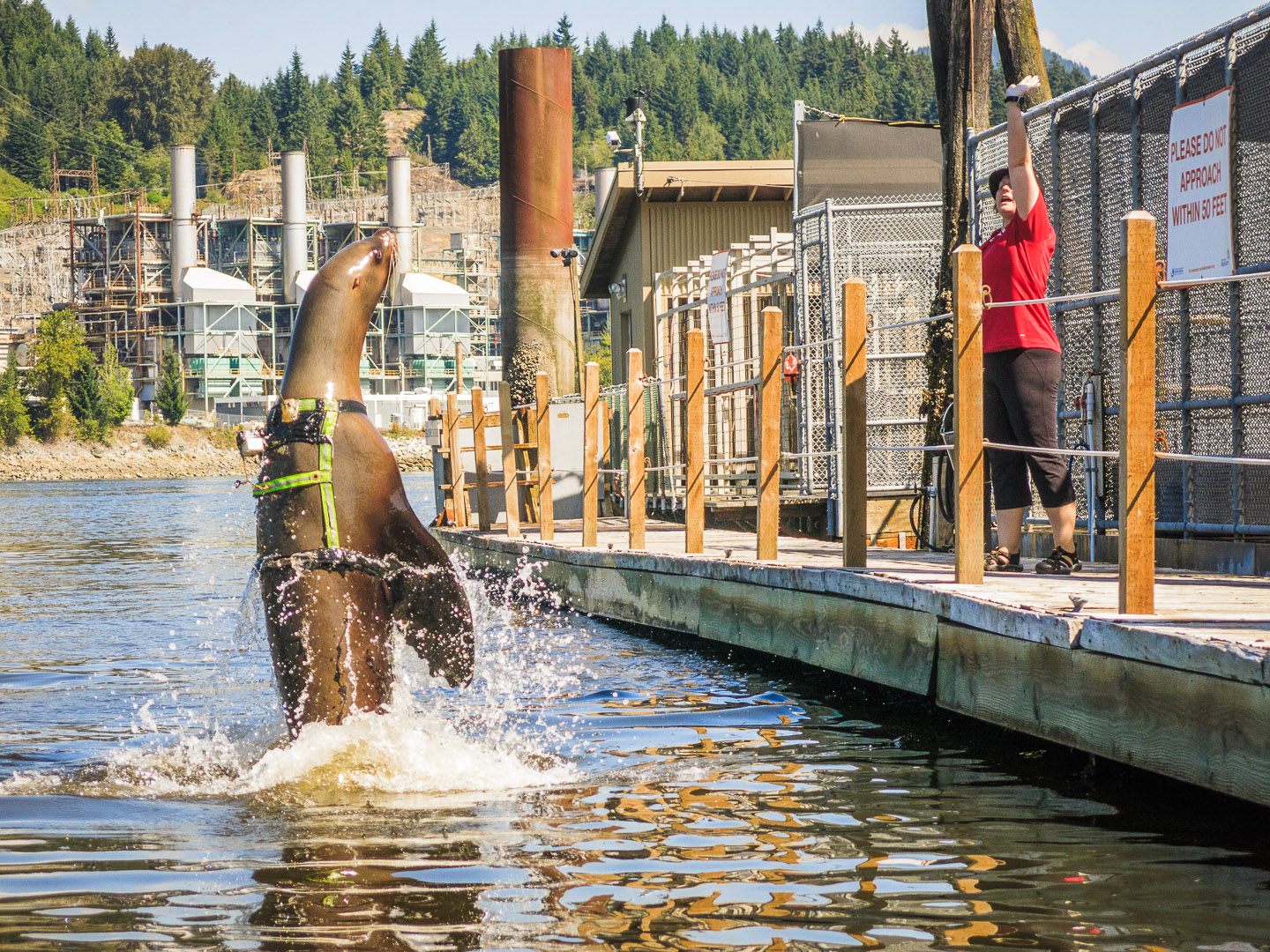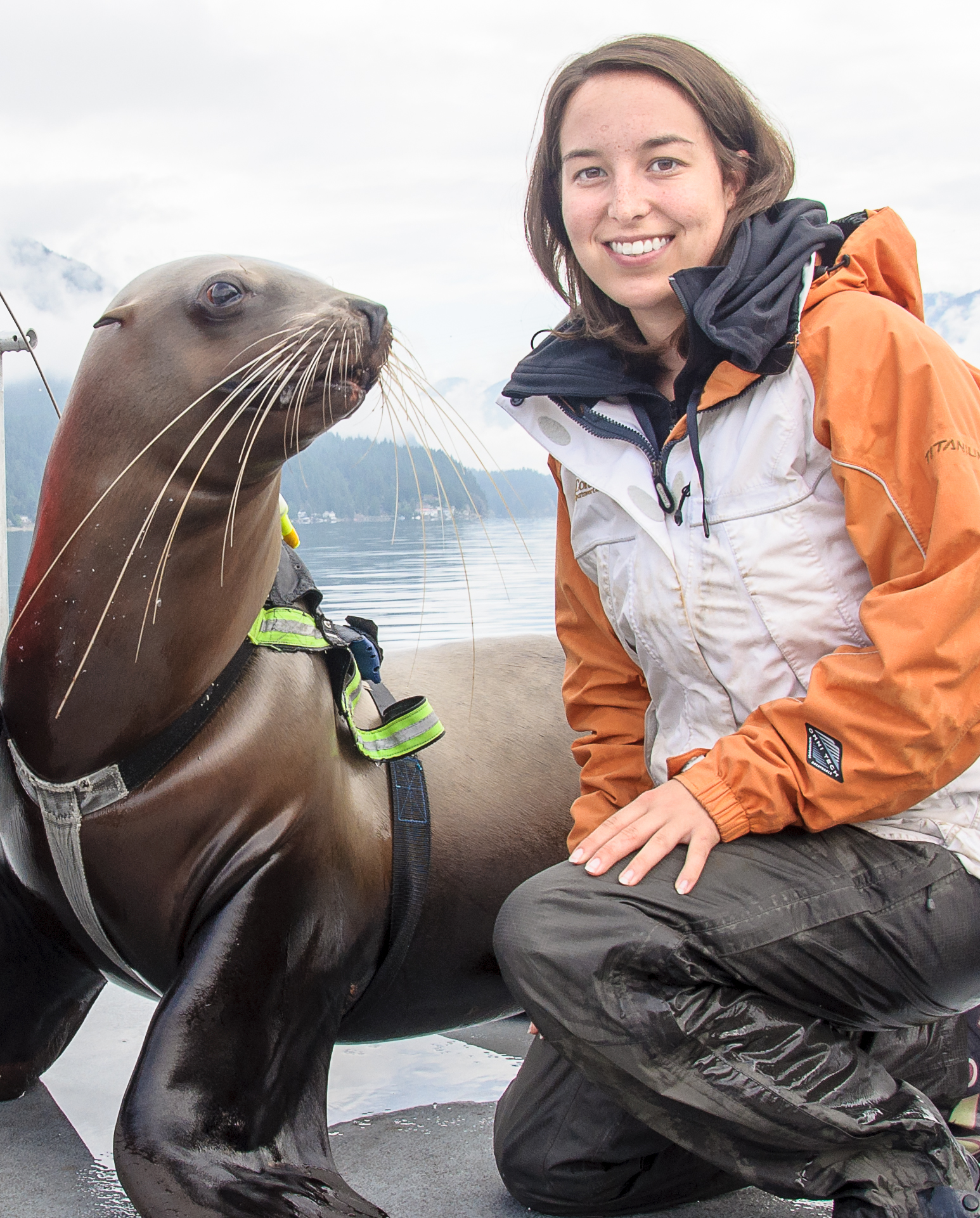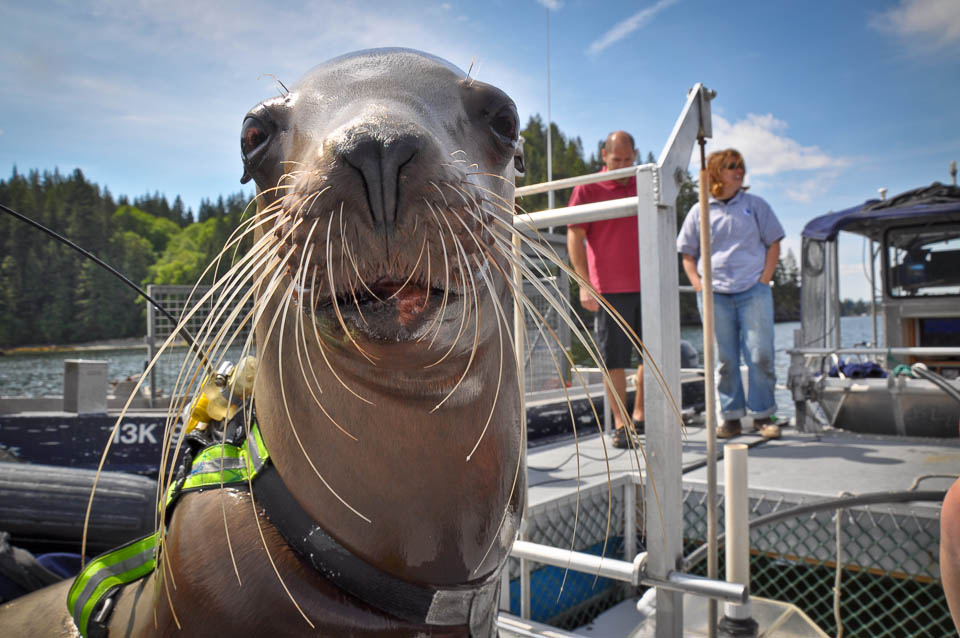
Open Water Research Station Contributes a Decade of Discoveries
This year marks the ten-year anniversary of the Open Water Research Station, a floating laboratory at the center of a ground-breaking scientific collaboration that has significantly advanced understanding of how nutritionally stressed Steller sea lions forage in the wild.

The harness worn by Sitka carries scientific instruments, a GoPro camera, and satellite tracking tag.
To mark this anniversary, Consortium researchers have published a comprehensive review of their key discoveries and insights on marine mammal diving physiology, contributed through dozens of studies and publications. The review was recently published in the Journal of Comparative Physiology B.
“Our success as a community of researchers is very reflective of the way good science works,” says David Rosen, lead author of the review article. “Ten years ago, we asked some very basic questions about the diving abilities of Steller sea lions. This led us down different scientific pathways and allowed us to uncover some surprising insights that have only been achieved for a very few species.”
Immense Gamble
The Open Water Research Station launched without fanfare in 2006, in a quiet harbor near Vancouver. A small cohort of Steller sea lions, once considered untrainable, had been taught to take part in research at the Vancouver Aquarium. But they were now faced with the daunting task of performing in the open ocean, without any physical restraints or barriers.
“This program was an immense gamble because nobody had tried working with Steller sea lions in the open water before,” says Rosen. “A lot of people said we were crazy. Just getting it going was a huge milestone.”
The research program led by Rosen and Andrew Trites seeks to understand how wild Steller sea lions survive in a dramatically changing ocean.

The Steller Shuttle is used to transport sea lions up the fjord, as well to conduct swimming studies testing biologging tags and the effects of ocean currents and tide changes on swimming performance. The Steller Shuttle uses a jet propulsion engine (that has no propeller) when the sea lions are swimming near the boat.
“When we change a variable in our experiments, like the amount of fish available at a certain depth, we’re ultimately trying to find out what would happen if something similar occurred in the wild,” says Rosen. “For example, what if their prey has moved or become less concentrated, or changed in composition? What if the animals are nutritionally stressed before they try to forage? How do these factors affect behavior in the wild?”
Because Steller sea lions are divers, the unique setting at the Open Water Research Station allowed Rosen and his colleagues to observe behaviors they would not have seen in an aquarium.
“There’s simply no other way of getting this information,” he says. “Monitoring wild animals doesn’t tell us why they’re making these choices at depth, and an aquarium has too many physical restrictions. No other research facility in the world has the capacity for doing this type of research with these animals.”
Unique Collaboration
Through a long-term partnership with the Vancouver Aquarium, the Open Water Research Station is staffed with full-time animal care professionals who are primarily concerned with the health and welfare of the animals. This allows the scientific teams to stay focused on experimental design and analysis, and to make the best use of their time with the animals.
“We work together as a team, understanding that none of us could succeed alone,” says Rosen. “The staff we’ve had over the decade — including researchers, postdoctoral fellows, graduate students, trainers and veterinarians — have been tremendously dedicated to the program.”
Collectively, this group has published 25 scientific papers and trained 5 graduate students from the University of British Columbia and other institutions.

Carling Gerlinsky is one of the graduate students who made new discoveries at the Open Water Research Station about the foraging abilities of Steller sea lions.
One of the graduate students, Carling Gerlinsky, studied how nutritional stress affects the ability of Steller sea lions to dive. She predicted that a sea lion that looses body mass due to eating less would store less oxygen in its tissue and blood when diving, and would ultimately have more difficulty foraging. Surprisingly, her measurements showed an increase in blood volume and red blood cells when nutritionally stressed, which allowed the sea lions to work harder to get the fish they needed. Her discovery has generated considerable interest in the research community. Another surprising finding was the realization that Steller sea lions are poor divers — their aerobic dive limit is only 3 minutes!
Another graduate student, Liz Goundie, studied diving behavior, and how the sea lions responded to changes in fish density at different depths. She found that when the sea lions were fed more fish at depth, they stayed underwater for longer. Although this meant they had to recover longer at the surface after a dive, Goundie concluded that the strategy of making one long, deep dive was much more energetically efficient than making several short dives to the same depth. “This type of knowledge about the foraging ecology of Steller sea lions cannot be obtained in the wild, but can only be found by running carefully controlled experiments”, says Rosen.
Critical Research
“We began this research program with a single question: What is the energetic cost of diving?” says Rosen. “We quickly realized that there is no single cost of diving—rather, there are a whole bunch of inter-related questions about what things affect the various costs of diving.”

Although our sea lions are free to leave at any time, none has ever chosen this option over staying with the trainers and research scientists. However, there have been occasions when the sea lions opted to swim back to the lab from the remote dive site rather than accept a free lift aboard their Steller Shuttle.
Rosen says one of his team’s big insights is that the sea lions employ different diving tactics in different situations. For example, they may choose to make one long dive or a series of short dives depending on the circumstances. Each choice produces a vastly different physiological response and prompts different behaviors at depth, which in turn influences foraging success.
The ten-year research program led by Rosen and Trites has provided an unprecedented window into Steller sea lion physiology and behavior. As wild populations decline sharply in Western Alaska, there has never been a more critical time for this research.
Rosen admits that the funding for the Open Water Research Station is uncertain beyond next year. He hopes that the scientific milestones summarized in the recent review will underscore the importance of renewed funding and action on behalf of dwindling Steller sea lion populations in the North Pacific.
“It would be a huge shame to stop now, given the incredible progress we’ve made,” he says.
 PUBLICATION
PUBLICATION
|

|

 |
||||||||||||
